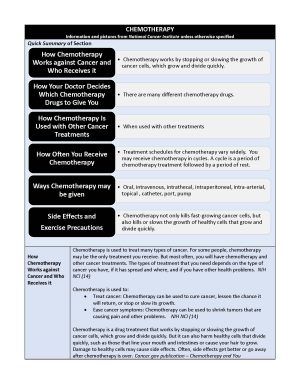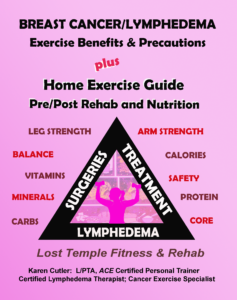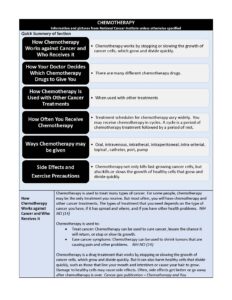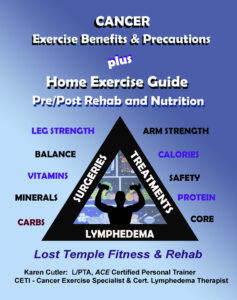What is
Chemotherapy
Your Body is Your Temple
Research, Resources & Education
Table of Contents
Chemotherapy is a drug treatment that works by stopping or slowing the growth of cancer cells, which grow and divide quickly. Damage to healthy cells may cause side effects. Often, side effects get better or go away after chemotherapy is over.
Information from the National Cancer Institute unless otherwise specified
What is Chemotherapy Used For ?
Cure Cancer
Slow Growth
Ease Symptoms
Neoadjuvant Therapy
This is called neoadjuvant chemotherapy.
Adjuvant Therapy
Assist
Kills Cancer Cells
Chemotherapy Videos
YouTube Videos that help explain Chemotherapy, Drugs and Ports.
Disclaimer:
This is for research only and Lost Temple Fitness & Cancer does not endorse any video presented on this website.
It is advised that you ALWAYS CHECK WITH YOUR PHYSICIAN for a proper diagnosis and treatment plan.
Chemotherapy
Ways Chemotherapy May be Given
The chemotherapy comes in pills, capsules, or liquids that you swallow.
The chemotherapy comes in a cream that you rub onto your skin.
The chemotherapy is given by a shot in a muscle in your arm, thigh, or hip, or right under the skin in the fatty part of your arm, leg, or belly
The chemotherapy is injected into the space between the layers of tissue that cover the brain and spinal cord
The chemotherapy goes directly into the peritoneal cavity, which is the area in your body that contains organs such as your intestines, stomach, and liver
The chemotherapy is injected directly into the artery that leads to the cancer
- The chemotherapy goes directly into a vein.
- Chemotherapy is often given through a thin needle that is placed in a vein on your hand or lower arm. Your nurse will put the needle in at the start of each treatment and remove it when treatment is over.
- IV chemotherapy may also be given through catheters or ports, sometimes with the help of a pump.
CATHETER
- A catheter is a thin, soft tube. A doctor or nurse places one end of the catheter in a large vein, often in your chest area. The other end of the catheter stays outside your body.
- Most catheters stay in place until you have finished your chemotherapy treatments.
- Catheters can also be used to give you other drugs and to draw blood. Be sure to watch for signs of infection around your catheter.
PORT
- A port is a small, round disc that is placed under your skin during minor surgery. A surgeon puts it in place before you begin your course of treatment, and it remains there until you have finished. A catheter connects the port to a large vein, most often in your chest.
- Your nurse can insert a needle into your port to give you chemotherapy or draw blood.
- This needle can be left in place for chemotherapy treatments that are given for longer than one day.
- Be sure to watch for signs of infection around your port.
PUMP
- Pumps are often attached to catheters or ports. They control how much and how fast chemotherapy goes into a catheter or port, allowing you to receive your chemotherapy outside of the hospital.
- Pumps can be internal or external. External pumps remain outside your body.
- internal pumps are placed under your skin during surgery.
Exercise Precautions or Per MD Recommendations
Information from CETI
Please follow MD/surgeon protocol, as every situation is unique.
NO EXERCISE
- Hematocrit less than 25%.
- Hemoglobin less than 24% 8g/dl due to anemia.
- White blood cell counts less than 300 mm3
NO EXERCISE for 24 Hours or Day of Chemo
- IV Chemotherapy
- Adriamycin use (doxorubicin) – No exercise on the day of chemo.
- May cause heart to bear irregularly for 24 hours, so only low impact exercise for 24-48 post treatment – no more than 15-20 beats over resting heart rate.
NO RESISTANCE TRAINING
- Platelet count less than 5000 mm3 – No resistance training – risk of internal bleeding/ hemorrhage.
GENTLE ACTIVE ROM
- Platelet count less than 30,000 mm3
Avoid public gyms
- White blood cell counts – Avoid public gyms unless blood cell count is above 500 mm3
Side Effects
- Chemotherapy not only kills fast-growing cancer cells, but also kills or slows the growth of healthy cells that grow and divide quickly.
- Examples are cells that line your mouth and intestines and those that cause your hair to grow.
- Damage to healthy cells may cause side effects, such as mouth sores, nausea, and hair loss. Side effects often get better or go away after you have finished chemotherapy.
The most common side effect is fatigue, which is feeling exhausted and worn out. You can prepare for fatigue by:
- Asking someone to drive you to and from chemotherapy.
- Planning time to rest on the day of and day after chemotherapy.
- Asking for help with meals and childcare on the day of and at least one day after chemotherapy
Cancer treatments can cause side effects—problems that occur when treatment affects healthy tissues or organs. Ask your health care team what side effects you are likely to have.
- Anemia
- Appetite Loss
- Bleeding and Bruising (Thrombocytopenia)
- Constipation
- Delirium
- Diarrhea
- Edema (Swelling)
- Fatigue
- Fertility Issues in Boys and Men
- Fertility Issues in Girls and Women
- Hair Loss (Alopecia)
- Infection and Neutropenia
- Lymphedema
- Memory or Concentration Problems
- Mouth and Throat Problems
- Nausea and Vomiting
- Nerve Problems (Peripheral Neuropathy)
- Pain
- Sexual Health Issues in Men
- Sexual Health Issues in Women
- Skin and Nail Changes
- Sleep Problems
- Urinary and Bladder Problems
Disclaimer: The information in this book/website is for educational purposes only and has been obtained through research, publications and personal experience, and shall not be liable for incorrect information. Any mentioned publications or websites does not imply endorsement. As this industry is ever changing, I urge readers to confirm the information contained in this book/website. The author will not be liable for any injuries sustained from practicing techniques taught or for any typographical errors or omissions.
It is advised that you always check with your medical doctor or physical therapist before starting an exercise program or change in diet.
|
Information and pictures from National Cancer Institute unless otherwise specified |




